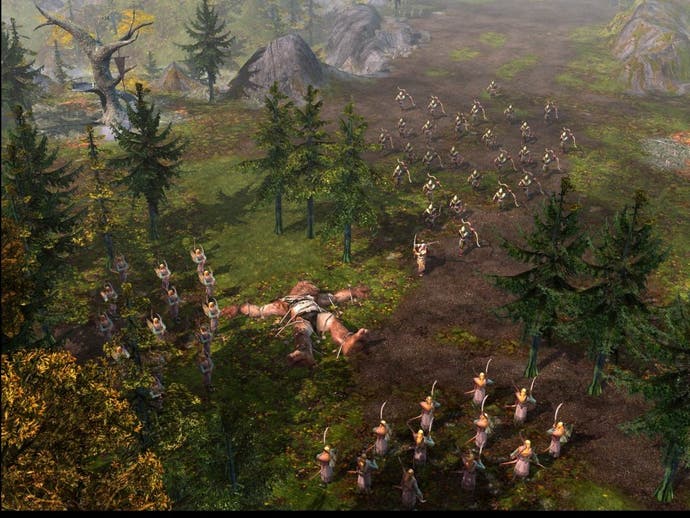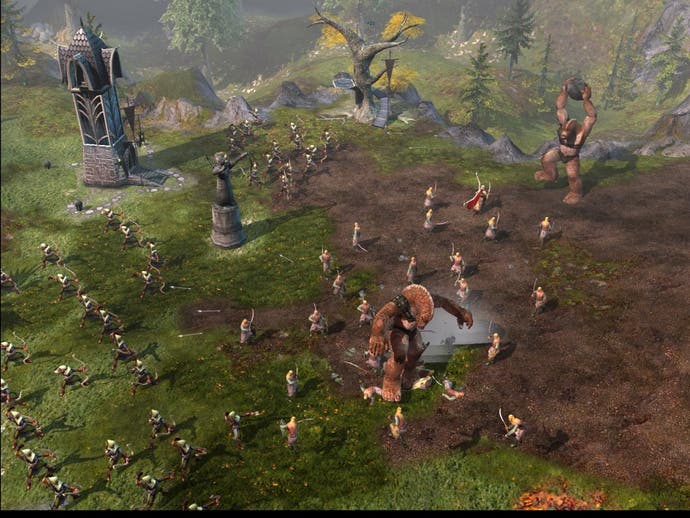The Battle For Middle-Earth II
Plotting against presumably evil people.
There's something dishonest about RTS multiplayer. Your enemy is not a single avatar to be hunted and shot - he is a system, a mechanism, an unseen controlling force. And he's out there, with malign intentions. With the fog of war blanking the field you can't tell exactly what he's up to. But it must be something sinister. It must be, because you know he's out to get you.
--- ENTERING LOBBY
"Hi"
"Hello there."
And then deafening silence as we engage each other for a tentative hour, ending in a mysterious disconnection... You face a neutral-green stats screen. He was winning! Did he just get bored? Did he fear my dwarf siege machines? We may never know.
Forgive me if I come across as a little paranoid, but playing extended sessions of RTS multiplayer gives me the willies. Silent, highly organised opponents array their powers against stupid, fumbling me, and it's a little bit frightening. I never quite got over the years of being pummelled at Warcraft 3 by my former boss. We were in the same room then, but nevertheless awkwardly silent. Clicking, always clicking... Deathmatch I can handle, racing I can handle: it's an honest man's work. But this secret resource management is the thing of the perfidious, the treacherous... A week of The Battle For Middle-Earth II multiplayer beta (on the PC, natch) has left me a bit jittery. And I keep thinking about self-mending towers and magic upgrades. Ah yes, the mithril shirts - just like what Kieron wears when we're out clubbing.

BFME2 may not be the most interesting RTS game I've played (that was Perimeter), but its one of the most intricate and well presented. The towering tech-trees provide a certain compulsion - if just to see how well your dwarven war machines are going to do against flying beasts and goblin hordes. As with the original game it all unfolds rapidly, but there's a lot to unfold - like undoing someone's clever origami, just to annoy them. Units have rather specific strengths and weaknesses and so applying them in the wrong situation is going to be fatal. The correct filling out of the tick-box list of clever play means putting your men in the right place at the right time, and not forgetting to use that fear spell. Usually this mean penetrating enemy defences with a wall-smashing entity of some description and following it up with deft application of the special powers of a few squads of shock troops - do all that without getting distracted and you're on your way to a win.
This rapidly realised sequel is, of course, just as pretty as its predecessor, but it also expands that basic model enormously. Previous combat dynamics (which now rely heavily on fortifications) remain much the same, but fresh meat comes with the new content. The newest factions include goblins and their ugly minions, dwarves and their engineers, and the poncy elves, who boast a voice-over by Agent Smith (who played the actor Hugo Weaving at the LOTR Oscars ceremony). Naturally each faction is fit to burst with heroes, and they are each capable of fielding dozens of specialised units against your silently clicking foe. Dragons and powerful magics represent the most epic moments of Tolkeinesque RTS fun, with my personal favourite being a giant meteor-lobbing tower that crests the dwarf fortresses. Watching your opponent's infantry go flying like in that first scene from Jackson's Fellowship of The Ring is deeply agreeable - that'll teach him to go plotting against me.

But there are tonnes of less spectacular units that are just as interesting and useful - sneaky hobbits, for example, or the many different hero characters (each with powers of his own) that you can bring into play. This is a game where unit upgrades count for everything, so getting the peripheral buildings up and your men into their maximal super-charged battle-axes is essential for victory. You can also supplement their abilities with a tech tree of mystical powers, which allows you to conjure up new monsters, defensive towers, lightning or healing energies to aid your troops. Come to think of it, that was a bit annoying and I kept forgetting about it, but it's there all the same...
And there's more! (Gosh!) The final game is going to be packed with new and fiddly-sounding features, such as being able to customise game avatars and have your personal heroes in-game. You'll also be able to customise the main fortress - the hub around which your battles revolve. (Building an unnecessarily elegant lattice of defence of defensive walls is already a grotesquely nerdy pleasure.)

In the single-player campaign this nonsense will once again be integrated into a macro-war that you wage across the face of the entire continent - like Total War only with more Hobbitses. Details like these should put BFME2 a few steps ahead of its contemporaries, and if it can maintain the balance and speed of warfare that it has displayed in the beta testing then this could genuinely be one to look forward to.
And you can look forward to it ten thousand times as much if you're an Xbox 360 owner (PC owners have their anticipation diluted by that same factor because there are already ten thousand RTS games available for their machine). But just how all this is going to pan out on poor old Xbox 360 is another matter. We'll let you know if EA's touted 'console specific' control system craps things up later in the spring. We're staying cautiously optimistic. (Or is that optimistically cautious?)
Anyway, how do I make a joke using the phrase 'digging your own glaive'? Anyone?




.png?width=291&height=164&fit=crop&quality=80&format=jpg&auto=webp)



